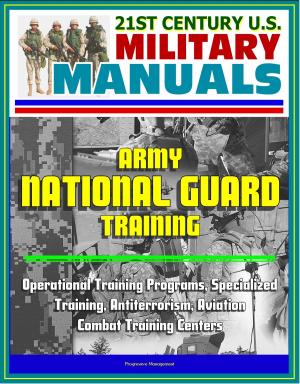2011 U.S. Marine Corps (USMC) Concepts and Programs: Comprehensive Guide to Weapons, Aviation, Command and Control, Ground and Combat Vehicles, Expeditionary and Maritime Support, Installations
Nonfiction, Social & Cultural Studies, Political Science| Author: | Progressive Management | ISBN: | 9781465872616 |
| Publisher: | Progressive Management | Publication: | July 27, 2011 |
| Imprint: | Smashwords Edition | Language: | English |
| Author: | Progressive Management |
| ISBN: | 9781465872616 |
| Publisher: | Progressive Management |
| Publication: | July 27, 2011 |
| Imprint: | Smashwords Edition |
| Language: | English |
This 2011 version of the annual U.S. Marine Corps Concepts and Programs document, totaling more than 400 pages, provides an encyclopedic summary of Marine Corps programs, weapons, equipment, and operational concepts. It provides a wealth of information about today's U.S. Marine Corps. They are America's expeditionary force in readiness.
Here are some of the topics covered (space limitations prevent a complete listing): Marine Air Ground Task Force (MAGTF) * Headquarters, U.S. Marine Corps * Operating Forces * Supporting Establishment * Marine Corps Embassy Security Group * Marine Barracks, Washington, D.C. * CHAPTER 3: Programs * Part 1: Equipping the Marines * Infantry Automatic Rifle (IAR) * Modular Weapons System (MWS) * Semi-Automatic Sniper System (SASS) * Multi-Shot Grenade Launcher * Shoulder Launched Multi-purpose Assault Weapon (SMAW II) * Handheld Radios Family of Systems (FOS) * Marine Enhancement Program (MEP) * Marine Expeditionary Rifle Squad (MERS) * Infantry Combat Equipment (ICE) * Tactical Hydrographic Survey Equipment (THSE) * Day Optics Systems * Thermal Optics Systems * Laser Targeting and Illumination Systems * Part 2: Command and Control * Marine Corps Information Enterprise (MCIENT) Strategy * Marine Corps Enterprise Information Technology Services (MCEITS) * Global Command and Control System (GCCS) * Global Combat Support System - Marine Corps (GCSS-MC) * Defense Readiness Reporting System - Marine Corps (DRRS-MC) * Common Aviation Command and Control System (CAC2S) * Theater Battle Management Core System (TBMCS) * Tactical Combat Operations (TCO) System * Composite Tracking Network (CTN) * Combat Operations Center (COC) * Mobile Modular Command and Control (M2C2) System * Joint Battle Command Platform (JBC-P) * Joint Tactical Common Operational Picture (COP) Workstation (JTCW) * Blue Force Tracker (BFT) Family of Systems * Warfighter Network Services-Tactical (WFNS-T) * The Assault Amphibious Vehicle-Command; C2 Upgrade Program * Multi-Band Radio (MBR) * High Frequency Radio (HFR) * Part 3: Intelligence, Surveillance, and Reconnaissance * Marine Corps Intelligence, Surveillance, and Reconnaissance Enterprise (MCISR-E) * Distributed Common Ground System-Marine Corps (DCGS-MC) * Communication Emitter Sensing and Attacking System (CESAS) * Joint Surveillance Target Attack Radar System (JSTARS) * Common Ground System (CGS) * Counterintelligence (CI) and Human Intelligence (HUMINT) Equipment Program (CIHEP) * much more.
America's Marines provide a large range of capabilities for the modest investment of our nation's scarce resources. In the most recent months and years, in locations all over the globe -Pakistan, Haiti, the Caribbean, the U.S. Gulf Coast, South America, the Gulf of Aden, the Philippines, and Afghanistan - Marine Corps forces were either engaging with our allies, conducting full spectrum counter-insurgency operations, enabling the Joint Force and Interagency Non-governmental Agency elements, providing humanitarian assistance and disaster relief, deterring aggression or contributing to assured access. Today's Marine Corps is a "middleweight force." We fill the void in our nation's defense for an agile force that is comfortable operating at the high and low ends of the threat spectrum or the more likely ambiguous areas in between. We will continue to support our national objectives in Afghanistan. Concurrently, we will modernize, reset and reconstitute our equipment in order to provide a balanced air-ground-logistics team that is forward deployed and forward engaged; shaping, training, deterring and responding to a wide variety of global crises and contingencies.
This is a privately authored news service and educational publication of Progressive Management.
This 2011 version of the annual U.S. Marine Corps Concepts and Programs document, totaling more than 400 pages, provides an encyclopedic summary of Marine Corps programs, weapons, equipment, and operational concepts. It provides a wealth of information about today's U.S. Marine Corps. They are America's expeditionary force in readiness.
Here are some of the topics covered (space limitations prevent a complete listing): Marine Air Ground Task Force (MAGTF) * Headquarters, U.S. Marine Corps * Operating Forces * Supporting Establishment * Marine Corps Embassy Security Group * Marine Barracks, Washington, D.C. * CHAPTER 3: Programs * Part 1: Equipping the Marines * Infantry Automatic Rifle (IAR) * Modular Weapons System (MWS) * Semi-Automatic Sniper System (SASS) * Multi-Shot Grenade Launcher * Shoulder Launched Multi-purpose Assault Weapon (SMAW II) * Handheld Radios Family of Systems (FOS) * Marine Enhancement Program (MEP) * Marine Expeditionary Rifle Squad (MERS) * Infantry Combat Equipment (ICE) * Tactical Hydrographic Survey Equipment (THSE) * Day Optics Systems * Thermal Optics Systems * Laser Targeting and Illumination Systems * Part 2: Command and Control * Marine Corps Information Enterprise (MCIENT) Strategy * Marine Corps Enterprise Information Technology Services (MCEITS) * Global Command and Control System (GCCS) * Global Combat Support System - Marine Corps (GCSS-MC) * Defense Readiness Reporting System - Marine Corps (DRRS-MC) * Common Aviation Command and Control System (CAC2S) * Theater Battle Management Core System (TBMCS) * Tactical Combat Operations (TCO) System * Composite Tracking Network (CTN) * Combat Operations Center (COC) * Mobile Modular Command and Control (M2C2) System * Joint Battle Command Platform (JBC-P) * Joint Tactical Common Operational Picture (COP) Workstation (JTCW) * Blue Force Tracker (BFT) Family of Systems * Warfighter Network Services-Tactical (WFNS-T) * The Assault Amphibious Vehicle-Command; C2 Upgrade Program * Multi-Band Radio (MBR) * High Frequency Radio (HFR) * Part 3: Intelligence, Surveillance, and Reconnaissance * Marine Corps Intelligence, Surveillance, and Reconnaissance Enterprise (MCISR-E) * Distributed Common Ground System-Marine Corps (DCGS-MC) * Communication Emitter Sensing and Attacking System (CESAS) * Joint Surveillance Target Attack Radar System (JSTARS) * Common Ground System (CGS) * Counterintelligence (CI) and Human Intelligence (HUMINT) Equipment Program (CIHEP) * much more.
America's Marines provide a large range of capabilities for the modest investment of our nation's scarce resources. In the most recent months and years, in locations all over the globe -Pakistan, Haiti, the Caribbean, the U.S. Gulf Coast, South America, the Gulf of Aden, the Philippines, and Afghanistan - Marine Corps forces were either engaging with our allies, conducting full spectrum counter-insurgency operations, enabling the Joint Force and Interagency Non-governmental Agency elements, providing humanitarian assistance and disaster relief, deterring aggression or contributing to assured access. Today's Marine Corps is a "middleweight force." We fill the void in our nation's defense for an agile force that is comfortable operating at the high and low ends of the threat spectrum or the more likely ambiguous areas in between. We will continue to support our national objectives in Afghanistan. Concurrently, we will modernize, reset and reconstitute our equipment in order to provide a balanced air-ground-logistics team that is forward deployed and forward engaged; shaping, training, deterring and responding to a wide variety of global crises and contingencies.
This is a privately authored news service and educational publication of Progressive Management.















